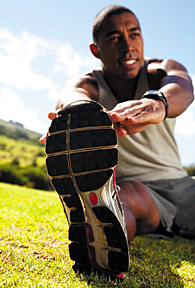Sit on the edge of a high desk or table with your feet and legs hanging off the table. Secure a weight with a strap around the instep of the foot. (Note: Make sure you are on a high table so the weight hanging below your foot does not touch the floor.) Bring the toes up toward the front of the leg by bending the ankle up.
You may also use a bungee cord in place of weights for resistance. Secure the bottom of the bungee cord to the floor and wrap the top of the bungee cord around the top of your foot; then lift your toes toward your leg by bending the ankle up. Perform this exercise 25 times, relax for 30 seconds, and then repeat 25 times for a total of 50 repetitions.
It is imperative to train the lower body with higher reps due to higher slow-twitch muscle fibers in the legs. Make sure to stretch the tight gastrocnemius muscles [calves] after warming up the muscle by walking for a few minutes. Stretch the muscle by keeping the involved leg back with the knee straight and heel on the floor. Slowly bend your front knee and lean onto wall until you feel the stretch in the calf. Hold for 30 seconds and repeat three times.
Cross the involved leg over the uninvolved leg. Pull your toes in the direction that will stretch the top of the leg away from the body. Hold for 30 seconds and repeat three times, three times a week. This protocol is used for balancing the weak muscles of the anterior [front] leg. Eventually, be sure to balance leg training by training the back of the leg [the calves and soleus muscles] To do this, you can perform seated calf raises and standing calf raises for one working set, 15-20 reps to failure, moving the weight slowly.
Place a 1-inch book or board under the front of the affected foot. Bend the nonaffected leg at the knee so that the nonaffected foot is off the ground. Hold on to a chair for added support. Push off the ball of the affected foot by lifting the heel off the ground. Perform this motion 25 times, relax 30 seconds, and then repeat 25 times, for a total of 50 repetitions. As the leg strengthens, increase the height of the book or board from 1 to 2 inches. Stretch the front and back of the lower leg at the end of the workout.
 Massage and Hydrotherapy: Under the direction of your chiropractor, sports massage therapy that includes hydrotherapy can be an effective treatment for shin splints. For acute shin pain, rest for 48-72 hours, ice using a towel as a barrier on the skin three times a day for 20 minutes per application. If shin splints are chronic, alternate hot and cold applications: 10 minutes hot-towel application followed by 10 minutes cold-towel application, three times a day. The heat will cause vassal dilation and the cold will cause vassal constriction. Dilation and constriction create a pumping effect, aiding in circulation. Massage will help stretch the tight muscles in and around the shin and increase circulation, helping the healing process while relieving pain.
Massage and Hydrotherapy: Under the direction of your chiropractor, sports massage therapy that includes hydrotherapy can be an effective treatment for shin splints. For acute shin pain, rest for 48-72 hours, ice using a towel as a barrier on the skin three times a day for 20 minutes per application. If shin splints are chronic, alternate hot and cold applications: 10 minutes hot-towel application followed by 10 minutes cold-towel application, three times a day. The heat will cause vassal dilation and the cold will cause vassal constriction. Dilation and constriction create a pumping effect, aiding in circulation. Massage will help stretch the tight muscles in and around the shin and increase circulation, helping the healing process while relieving pain.
Always talk to your doctor first if you suspect shin splints so they can diagnose the condition and make appropriate recommendations for treatment/care. There are also conditions that mimic shin splints, but may actually indicate more severe involvement of the shin and/or lower leg, so a qualified, comprehensive evaluation is always the first step.
Robert Lucarelli, LMT, is a licensed massage therapist and an exercise rehab therapist in Winter Park, Fla.

